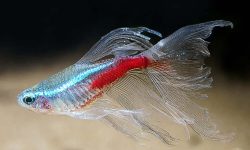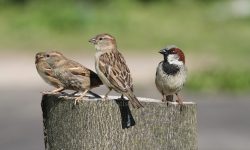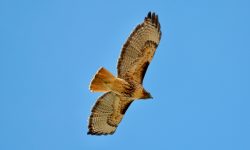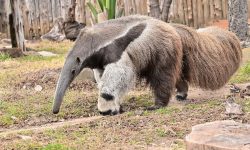When people hear the word “vampire,” they often think of gothic legends, horror films, or nocturnal predators. But in the natural world, the term refers to something very real: vampire bats—the only mammals that survive exclusively on blood. Surprisingly, only three species of bats in the world exhibit this highly specialized feeding behavior, and they all belong to a single subfamily: Desmodontinae. These are the Common Vampire Bat (Desmodus rotundus), the White-winged Vampire Bat (Diaemus youngi), and the Hairy-legged Vampire Bat (Diphylla ecaudata).
This article explores the unique biology, hunting techniques, ecological roles, and evolutionary adaptations of the world’s only true vampire bats.
What Makes a Vampire Bat?
True vampire bats are defined by their reliance on hematophagy, the consumption of blood as their primary or exclusive source of nutrition. This extreme dietary niche requires a suite of adaptations:
- Heat sensors to locate blood-rich areas
- Razor-sharp incisors to make painless incisions
- Anticoagulant saliva to keep blood flowing
- Highly specialized kidneys and guts to process a liquid, protein-rich diet
These traits are not found in most bats, making vampire bats an evolutionary rarity.
1. Desmodus rotundus – The Common Vampire Bat
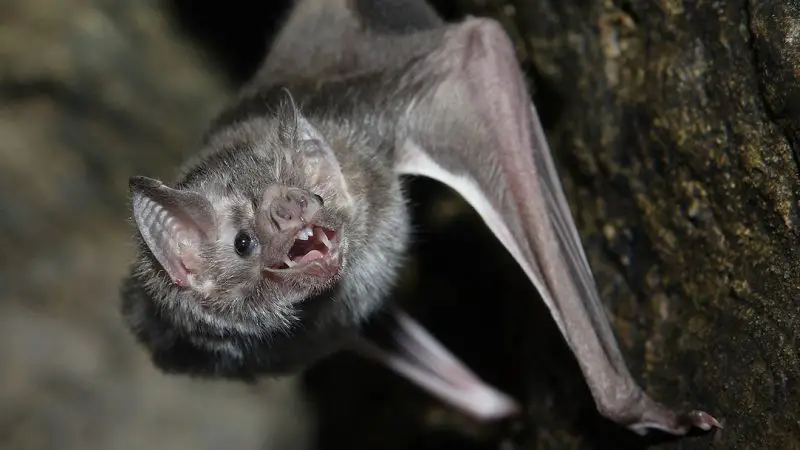
Habitat and Distribution
Desmodus rotundus, commonly known as the common vampire bat, is the most widespread and extensively studied of the three vampire bat species. Its range stretches from northern Mexico all the way down to northern Argentina, encompassing much of Central and South America.
This species is remarkably adaptable, thriving in a variety of habitats including tropical forests, scrublands, dry savannas, and agricultural areas. It often roosts in caves, hollow trees, abandoned buildings, wells, and even in livestock shelters, where access to blood-rich prey is convenient. Their ability to coexist near human settlements has significantly contributed to their ecological success.
Feeding Behavior
Despite their infamous reputation, common vampire bats are stealthy and highly specialized feeders. Their diet consists exclusively of blood from mammals, with livestock such as cattle, horses, and donkeys being their preferred targets due to their size, abundance, and thin skin.
Rather than swooping down like a predator, the bat lands on the ground a short distance from its intended host and crawls silently toward an exposed area, typically the ankle, neck, or abdomen. It uses infrared-sensitive pits on its nose to detect the warmest blood vessels beneath the skin. Once it locates a suitable spot, it makes a tiny, precise incision with its razor-sharp upper incisors.
The bat’s saliva contains a powerful anticoagulant called draculin, which inhibits blood clotting and allows a steady flow of blood during feeding. This process can last up to 30 minutes, and because the wound is so small and painless, the animal often doesn’t notice the intrusion at all.
Social Intelligence
Beyond their unique feeding behavior, common vampire bats are also notable for their exceptionally complex social structure and intelligence. One of the most remarkable behaviors observed in these bats is reciprocal food sharing.
If a bat fails to feed during the night—a situation that could be fatal due to their high metabolism—it can approach a roost-mate who successfully fed. The well-fed bat may regurgitate blood to nourish the hungry individual, especially if they share a history of cooperation. This altruistic behavior is governed by memory and social bonds, as bats tend to share only with individuals who have previously shared with them or with close relatives.
In addition to food sharing, these bats groom each other frequently and communicate through a variety of vocalizations, helping to maintain strong social connections and minimize conflict within the colony. Such behavior reflects a level of cognitive sophistication rarely seen in other mammals of similar size.
2. Diaemus youngi – The White-winged Vampire Bat
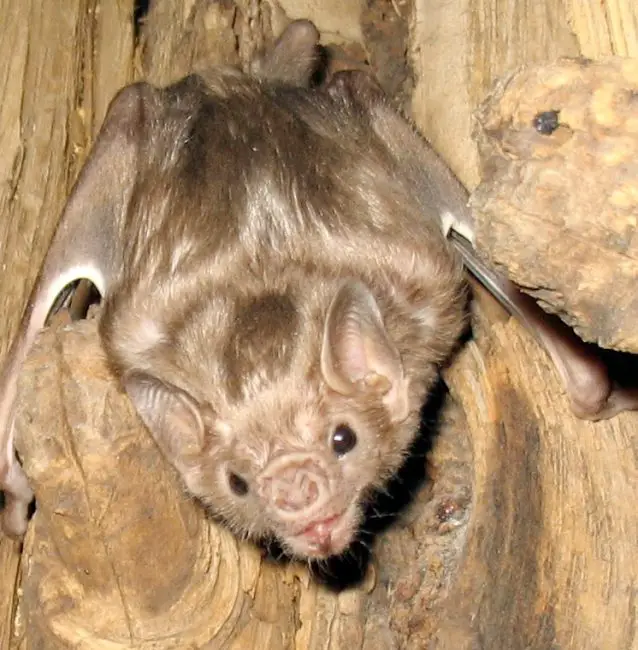
Appearance and Habitat
Diaemus youngi, known as the white-winged vampire bat, is a lesser-known and more elusive member of the vampire bat family. It is distinguishable from its relatives by its striking white patches on the wings, shorter and broader snout, and generally smaller size. These physical features not only aid in species identification but may also relate to its unique feeding preferences and foraging style.
This bat’s distribution spans from southern Mexico through Central America and into northern and central South America, including countries like Brazil, Peru, and Bolivia. However, it is considered rare or underreported in much of its range due to its secretive nature and preference for remote, densely forested habitats. Unlike the more commonly seen Desmodus rotundus, the white-winged vampire bat avoids human-modified environments and is seldom encountered near open pastures or livestock facilities.
Dietary Specialization
Diaemus youngi exhibits a remarkable dietary specialization, feeding almost exclusively on the blood of birds. It primarily targets roosting avian species, such as domestic fowl, wild ground-nesting birds, and forest-dwelling birds that sleep low to the ground or in accessible perches.
This bat uses a stealthy approach to feeding, much like its relatives, but it is especially adapted to exploit the stationary and vulnerable state of birds during nocturnal roosting. It selects areas with high bird densities, such as forest edges, riparian zones, or near poultry farms, which provide reliable access to prey.
Its feeding technique is thought to be less reliant on heat-sensing than that of Desmodus rotundus, likely due to the lower body temperature and thinner skin of birds compared to mammals. Nonetheless, it still uses sharp incisors to make tiny incisions and laps up the blood with its grooved tongue.
Roosting and Behavior
Although much less is known about the ecology and social life of Diaemus youngi, available observations suggest that it tends to roost in small colonies, typically consisting of a few individuals to a few dozen. Preferred roosting sites include hollow tree trunks, rock crevices, and occasionally abandoned burrows or sheltered forest debris. These secluded sites offer protection from predators and climatic extremes in the humid tropical environments where it resides.
Unlike the highly social Desmodus rotundus, the white-winged vampire bat is thought to be more solitary or loosely social. Its calls and social interactions have not been studied in detail, and there is limited evidence regarding food sharing or cooperative behavior.
Importantly, due to its avian-specific diet, Diaemus youngi is not considered a threat to livestock or human health. However, in areas near poultry farms, it may be of minor concern due to occasional feeding on domestic birds.
3. Diphylla ecaudata – The Hairy-legged Vampire Bat
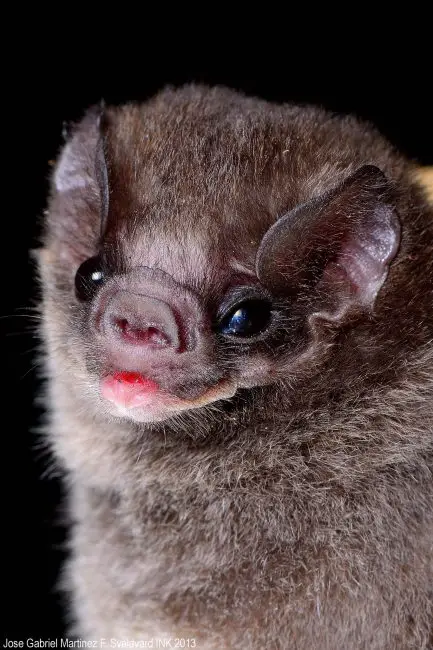
Distinguishing Traits
Diphylla ecaudata, commonly known as the hairy-legged vampire bat, is the most specialized and least commonly encountered of the three vampire bat species. It is named for the conspicuously dense fur covering its legs, a feature that sets it apart morphologically and may serve as insulation or aid in stealth during feeding.
This bat is native to the humid, tropical lowland forests that stretch from southern Mexico through Central America and into parts of central South America, including Brazil, Peru, and Paraguay. It typically inhabits undisturbed rainforest interiors, far from human settlements, which contributes to the species’ elusive nature and the limited amount of research available.
Diphylla ecaudata is smaller than Desmodus rotundus but similar in size to Diaemus youngi, with a compact body and a noticeably broad, flattened face. It also lacks an external tail—a trait reflected in its species name “ecaudata,” meaning “tailless”—which may enhance maneuverability within its dense, cluttered roosting environments.
Feeding Preferences
This species exhibits a strong preference for avian prey, feeding almost exclusively on birds—both wild and domestic. Unlike Desmodus rotundus, which targets large mammals, Diphylla ecaudata typically feeds on roosting birds such as pigeons, chickens, and various species of ground-nesting or canopy birds.
Using its small size and quiet approach, it lands near sleeping birds under cover of night, then crawls carefully toward the bird to avoid waking it. The feeding process is subtle and efficient. Though less is known about its sensory systems, it likely relies on a combination of auditory cues and close-range thermal or tactile sensing to locate a suitable feeding site.
Its feeding behavior is highly adapted to avian anatomy. Birds have feathers, thin skin, and a much lower body temperature than mammals. Diphylla ecaudata’s short, wide snout and sharp incisors are designed to slice through feathers and delicate skin with minimal disturbance. The bat’s bites are typically shallow but sufficient to draw blood, which it laps up using its grooved tongue in a manner similar to the other two vampire species.
Unique Morphology
In addition to its hairy legs and tailless body, Diphylla ecaudata has several anatomical traits tailored to its unique feeding strategy. The broad, flat face gives the bat a “pug-nosed” appearance, and its blunt rostrum allows for close facial contact with feathered prey.
Its dentition is modified for precision cutting rather than deep penetration. The incisors are finely honed to make tiny, scalpel-like incisions that bleed just enough to sustain the bat without inflicting serious damage. These adaptations ensure the bat can feed multiple times from the same bird or group of birds without immediately compromising their health—though repeated bites can eventually cause harm or stress.
While detailed studies on its social behavior are lacking, Diphylla ecaudata is generally believed to roost in small, scattered groups within hollow trees, caves, or crevices. Its secretive lifestyle and specialized diet have kept it largely out of contact with humans, and it poses no significant threat to livestock.
Shared Adaptations for Blood Feeding
Despite their differences in prey preference—Desmodus rotundus favoring mammals, while Diaemus youngi and Diphylla ecaudata specialize in birds—all three vampire bat species share a remarkable suite of adaptations that allow them to feed exclusively on blood, a diet known as hematophagy. This feeding strategy is highly demanding, and these bats have evolved several unique physiological, anatomical, and biochemical traits to meet those challenges.
1. Specialized Teeth
Vampire bats possess razor-sharp upper incisors that are not only finely honed for slicing but also grow continuously throughout their lives. Unlike other mammals whose teeth wear down with age, these bats maintain sharpness by self-sharpening edges, ensuring clean and silent incisions every time they feed.
The teeth are designed to cut the skin without pressing too deeply, minimizing trauma and reducing the chance of waking the prey. This surgical precision allows them to access blood with minimal detection, making the feeding process more efficient and less risky.
2. Heat-Sensing Structures
In Desmodus rotundus, evolution has produced a remarkable adaptation for locating blood-rich areas: infrared-sensitive pit organs located on the nose. These heat sensors function much like those found in pit vipers, detecting subtle temperature variations on the surface of a prey’s body.
This capability enables the bat to identify superficial blood vessels even in total darkness. While this adaptation is most prominent in Desmodus, similar—though less developed—mechanisms may exist in the bird-feeding species, aiding them in selecting appropriate feeding sites based on surface warmth and vascularization.
3. Saliva as a Weapon
All three vampire bats produce anticoagulant-rich saliva, which is essential for uninterrupted feeding. The most well-studied compound in this saliva is draculin, a glycoprotein found in Desmodus rotundus, which prevents blood from clotting at the site of the bite.
This natural blood thinner allows the bat to feed for extended periods—often up to 30 minutes—without the wound sealing. The medical potential of draculin is significant: researchers are exploring its use as a therapeutic agent for preventing blood clots and treating strokes, due to its targeted and reversible action on clotting factors.
Additionally, the saliva contains mild anesthetic properties, which may help reduce discomfort at the wound site, further decreasing the chance that the prey will wake and defend itself.
4. Light Skeleton and Efficient Digestion
Feeding on blood presents serious metabolic challenges: it is heavy in volume but low in caloric value, and contains large amounts of liquid and iron. To compensate, vampire bats have evolved an unusually lightweight skeletal structure, reducing the energy required for flight after feeding on a heavy blood meal.
Moreover, their digestive and excretory systems are highly specialized. As soon as feeding begins, the bat starts to rapidly eliminate excess water through highly efficient kidneys, reducing its weight before it takes off. Simultaneously, the bat retains and processes essential nutrients, extracting proteins and iron with remarkable speed and precision.
This adaptation allows vampire bats to remain agile and mobile even after ingesting a meal that can double their body weight in under an hour.
Why Are There Only Three Vampire Bat Species?
Hematophagy is a rare and risky feeding strategy. It requires specialized anatomy, and dependence on a single food source increases vulnerability. Evolutionary pressures such as food availability, host defense, and climate limit how many species can adapt to such a niche.
Additionally, the three species likely share a common ancestor and diverged relatively recently (within the last 25 million years), rather than hematophagy evolving multiple times independently.
Ecological Roles and Human Interaction
While often vilified, vampire bats play a significant ecological role:
- They help control bird populations
- Serve as prey for owls, snakes, and other predators
- Participate in forest nutrient cycling through waste products
However, their interaction with livestock and human populations has made them targets for culling due to their role in transmitting rabies in Latin America. Conservationists now focus on vaccination and habitat management instead of indiscriminate eradication.
Conclusion
The Common Vampire Bat, White-winged Vampire Bat, and Hairy-legged Vampire Bat are the world’s only true hematophagous mammals. Though often feared and misunderstood, these bats are evolutionary marvels, exhibiting remarkable adaptations in anatomy, behavior, and physiology. As science continues to reveal the complexity of their lives—from social cooperation to biomedical potential—it becomes clear that these creatures deserve deeper understanding, not dread.
They are not creatures of myth, but of extraordinary natural design—silent, precise, and essential members of the ecosystems they inhabit.

